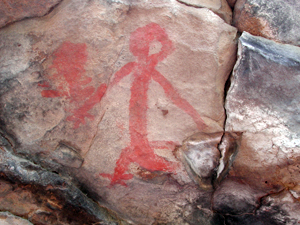|
What kinds of rock art images have been identified?
American Indians in Arkansas made rock art illustrating a wide variety of subjects. Some are easy to identify and others remain mysterious, though archeologists and anthropologists hope that new studies of these images will help us to understand more about them. The scientific mind delights in setting up neat typologies for everything, but with rock art it is not so easy. At this point in our research, we can provide some general categories of the different subject matter, arrangement of images, and techniques for making rock art.
Categories by Technique
Most pictographs in Arkansas are made with red paint. Black is the second most common color used. White and yellow are rare. Stick-figures or outline drawings are more common than solid "filled-in" figures, though the latter are found at a few of the most important sites.
The same can be said for petroglyphs. Most are pecked as outlines or stick figures, but some create solid figures by pecking or abrading "between the lines" to make the whole image. A few have pigment added.
Categories by Subject Matter
In general, we might break down the subject according to whether it is representational, geometric, or abstract, but these distinctions did not necessarily have much importance in the cultures that made the rock art. Representational would simply mean that the art resembles something we can recognize: it is either a naturalistic or a somewhat stylized image of a person, animal, plant, or other object from nature (for example, the sun), or perhaps an object manufactured by people, an artifact such as an arrow, a mask, or a mace. Arkansas has examples of all these. However, even though they are naturalistic in appearance, they might still have mythological or other symbolic meaning. The sun, for instance, could be a fertility symbol, and a mace (a ceremonial axe) was an important element in the religious iconography of late prehistory and a symbol of elite religious and political roles.
Geometric rock art includes designs based on the simple geometric shapes: circles, dots, lines, squares, triangles, diamonds, and so on. If we just count up the number of individual rock art elements in the state of Arkansas, geometrics are the most numerous category. Some geometric motifs are simple, but others are quite complex: patterns of repeating nested diamonds or triangles, for example, that look very much like the designs in woven basketry.
The abstract category is the most enigmatic of all. These images are not representational (or at least, we cannot recognize them as such), but too amorphous and irregular to be described according to familiar geometric shapes.
Categories by Arrangement
Another way to classify rock art is according to its immediate artistic context; in other words, its relationship to other rock art. Some images are isolated, some occur in panels (two or more images meant to be seen together), and some panels form a scene (where the images relate to one another as in a narrative). Defining an isolated image can be surprisingly difficult. If there is only one image at a site, there is no problem. But suppose there are three or four images at one site. How close together do they have to be before we consider them a panel? Let's say there are several images at one site, but separated from each other, in different parts of the cave. For all we know, they weren't even created in the same century. On the other hand, one person could have added his image a hundred years later in direct response to an earlier image, knowing that the site was "a place for making art," and adding his own bit to "the story" told at the cave. Is that a panel? The fact is, unless we are talking about dark zone caves, where artificial light has to be brought in (and we have not yet discovered any dark zone rock art in Arkansas) we don't know how big the "screen" was for viewing rock art.
To see some examples of all the different kinds of rock art images found in Arkansas, look at the photographs in the Gallery section of this website, or search the Database.
|
